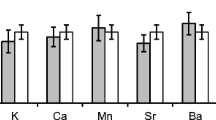Abstract
The effectiveness and success of antituberculosis therapy is mainly measured by its ability to identify the organism in the sputum. In certain cases, available tuberculosis tests are not satisfactory and do not provide enough information on the effectiveness of antituberculosis therapy. Copper (Cu), zinc (Zn), and selenium (Se) are the essential elements that play a crucial role in the immune system. The serum levels of these elements vary in many diseases including tuberculosis. In this study, we investigate whether the serum levels of Cu, Zn, and Se change during antituberculosis therapy. We have included 22 pulmonary tuberculosis cases that were newly diagnosed with positive sputum and 18 healthy subjects. At the beginning and 2 mo after therapy, serum levels of Cu, Zn, and Se were measured by atomic absorption spectrometry. Despite Se and Cu levels not being affected during the treatment, we found that there was a significant increase in the levels of Zn and a decrease in the Cu/Zn ratio. Serum Zn levels and the Cu/Zn ratio could be used as a valuable laboratory tool for the clinicians to assess response to therapy or effectiveness of the ongoing antituberculosis therapy.
Similar content being viewed by others
References
K. H. Falchuk, Disturbances in trace element metabolism, in Harrison’s Principles of Internal Medicine, 12th ed., J. D. Wilson, ed., McGraw-Hill, Taiping, China, pp. 443–445 (1991).
D. N. McMurray, R. A. Bartow, C. L. Mintzer, and E. H. Frontera, Micronutrient status and immune function in tuberculosis, Ann. NY Acad. Sci. 38, 287–292 (1995).
F. Tekşen, D. Mungan, and A. Sayal, Serum and pleural fluid selenium, copper, zinc and magnesium levels in malignant and non-malignant pleural diseases, Respiration 63, 25–27 (1996).
K. Mengübaş, N. A. Diab, and G. Gökmen, Selenium status of healthy Turkish children, Biol. Trace Element Res. 54, 163–172 (1996).
A. R. Lawton, Atomic absorption spectrometry methods, in Atomic Absorption Spectrometry Methods Manual, A. R. Lawtom, ed., Unicam, London, pp. 7–18 (1994).
N. Çetinkaya, D. Çetinkaya, and M. Yüce, Serum copper, zinc levels and copper-zinc ratio in healthy women and women with gynecological tumours, Biol. Trace. Element Res. 18, 29–38 (1988).
T. Oyama, K. Matsuno, and T. Kawamoto, Efficiency of serum copper/zinc ratio for differential diagnosis of patients with and without lung cancer, Biol. Trace. Element Res. 42, 115–127 (1994).
H. Howard, Trace metals and neoplasia, Clin. Physiol. Biochem. 4, 99–111 (1986).
W. C. Willett, B. F. Polk, and J. S. Morris, Prediagnostic serum selenium and risk of cancer, Lancet 16, 130–133 (1983).
M. Diez, F. J. Cerdan, M. Arroyo, and L. Balibrea, Use of the copper/zinc ratio in the diagnosis of lung cancer, Cancer 63, 726–730 (1989).
T. Byers, What can randomized controlled trials tell us about nutrition and cancer prevention? CA Cancer 49(6), 353–361 (1999).
E. Karyadi, W. Schultink, and R. H. Nelwan, Poor micronutrient status of active pulmonary tuberculosis patients in Indonesia, J. Nutr. 130, 2953–2958 (2000).
M. Ray, L. Kumar, and R. Prasad, Plasma zinc status in Indian childhood tuberculosis: impact of antituberculosis therapy, Int. J. Tuberc. Lung Dis. 2(9), 719–725 (1998).
V. I. Zozuliak, The role of and changes in the copper and zinc levels and the activity of their related metalloenzymes in the blood of patients with destructive pulmonary tuberculosis during chemotherapy, Lik. Sprava 5(6), 97–100 (1995).
B. Hua, Clinical value of serum copper, zinc and copper/zinc ratio in the differentiation of sarcoidosis from pulmonary tuberculosis and pulmonary carcinoma, Zhonghua Jie He He Hu Xi Za Zhi 12(4), 212–213 (1989).
M. A. Salih, E. F. Mohamed, and V. Galgan, Selenium in malnourished Sudanese children: status and interaction with clinical features, Ann. Nutr. Metab. 38, 68–74 (1994).
V. Voyatzoglou, T. Mountokalakis, and V. Tsata-Voyatzoglou, Serum zinc levels and urinary zinc excretion in patients with bronchogenic carcinoma, Am. J. Surg. 144, 355–358 (1982).
B. F. Issell, B. V. MacFadyen, and E. T. Gum. Serum zinc levels in lung cancer patients, Cancer 47, 1845–1848 (1981).
D. R. Zhang. Determination of zinc, copper, iron and zinc/copper ratio in the hair of active pulmonary tuberculosis patients, Zhonghua Jie He He Hu Xi Za Zhi 14(3), 170–172 (1991).
K. J. Yu, Determination and analysis of some serum trace elements of active pulmonary tuberculosis, Zhonghua Jie He He Hu Xi Za Zhi 12(1), 10–11 (1989).
Author information
Authors and Affiliations
Rights and permissions
About this article
Cite this article
Ciftci, T.U., Ciftci, B., Yis, Ö. et al. Changes in serum selenium, copper, zinc levels and Cu/Zn ratio in patients with pulmonary tuberculosis during therapy. Biol Trace Elem Res 95, 65–71 (2003). https://doi.org/10.1385/BTER:95:1:65
Received:
Accepted:
Issue Date:
DOI: https://doi.org/10.1385/BTER:95:1:65




